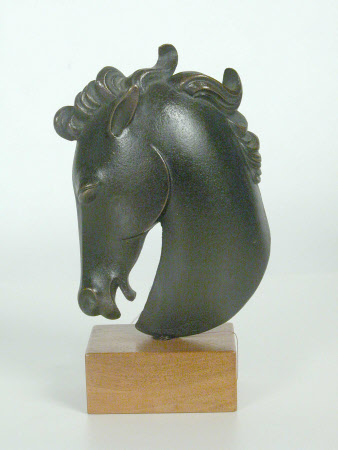Horse's head
László Hoenig (1905-1971)
Category
Art / Sculpture
Date
1933 - 1948
Materials
Bronze and wood
Measurements
152 x 104 x 46 mm
Place of origin
England
Order this imageCollection
Upton House, Warwickshire
NT 446628.7
Summary
A stylised bronze horse’s head designed and made by László Hoenig (1905-1971). The horse’s ear is folded back and its mane is crested; mounted on a rectangular light-coloured wooden plinth. On the underside of the base, Laszlo Hoenig’s stamp, with his monogram LHL.
Full description
László Hoenig (1905-1971) was a modernist architect, interior designer and cabinet-maker. Born in the last decades of the Austro-Hungarian empire, he studied in Germany at the Bauhaus in the late 1920s and practised in Berlin until 1933, when he emigrated to Britain. He set up a design studio and showroom in central London, running a successful business as an interior designer and maker of bespoke furniture, working mostly for private and corporate clients, until his death in 1971. For Hoenig and his career, see Duane Kahlhamer, ‘Individualist in Mayfair: Laszlo Hoenig: Architect, Interior Designer’, The Journal of the Decorative Arts Society 1850 - the Present, No. 32, Design and the Decorative Arts in Post-war Britain (2008), pp. 30-53. See also the website being developed by Hoenig’s son John, http://www.laszlohoenig.com/LH/Laszlo_Hoenig.html. Lord Bearsted was active in the early 1930s in assisting those who wanted to emigrate from Germany to Britain and other countries. He commissioned several works from another emigré, Artur Immanuel Loewental (see NT 446628.1-6), and may have acquired this work from Hoenig in the same spirit. However, this small sculpture was not commissioned, but was one of the works that could be bought from Hoenig’s shop in South Audley Street, Mayfair. (Kahlhamer, p. 46). These included galloping horses and horses’ heads, birds in flight, busts, torsos, fruit bowls, and other animals. An illustrated catalogue, Fine Gifts: Laho Art Works, published in the 1940s, described these products as 'contemporary design by skilled British craftsmen … created to enhance and enrich the modern home.' They were marketed under the brand name 'Laho Art Works', and were stamped LAHO LONDON and MADE IN ENGLAND. Some, including this horse’s head, also bore Hoenig’s monogram LHL, in the style of the Wiener Werkstätte. The theme of the horse was one of László Hoenig’s favourite subjects; this particular treatment was influenced by the work of the Viennese Hagenauer workshop (information from John Hoenig). Jeremy Warren (August 2018)
Provenance
Acquired by Walter Samuel, 2nd Viscount Bearsted; given with Upton House to the National Trust by Walter Samuel, 2nd Viscount Bearsted (1882 – 1948), in 1948.
Credit line
National Trust Collections (Upton House, The Bearsted Collection)
Marks and inscriptions
Underside of base: LAHO/LONDON/LHL in monogram/MADE IN/ENGLAND
Makers and roles
László Hoenig (1905-1971), sculptor
References
Michaelis 1882: Adolf Michaelis, Ancient Marbles in Great Britain described by Adolf Michaelis, Cambridge 1882
